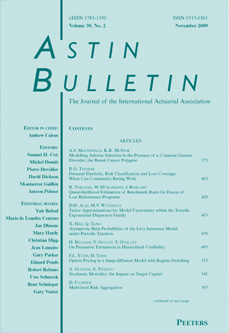next article in this issue  |

|
Document Details : Title: On Maximum Likelihood and Pseudo-Maximum Likelihood Estimation in Compound Insurance Models with Deductibles Author(s): PAULSEN, Jostein , STUBØ, Knut Journal: ASTIN Bulletin Volume: 41 Issue: 1 Date: 2011 Pages: 1-28 DOI: 10.2143/AST.41.1.2084384 Abstract : Non-life insurance payouts consist of two factors: claimsizes and claim frequency. When calculating e.g. next years premium, it is vital to correctly model these factors and to estimate the unknown parameters. A standard way is to separately estimate in the claimsize and the claim frequency models. Often there is a deductible with each single claim, and this deductible can be quite large, particularly in inhomogeneous cases such as industrial fire insurance or marine insurance. Not taking the deductibles into account can lead to serious bias in the estimates and consequent implications when applying the model. When the deductibles are nonidentical, in a full maximum likelihood estimation all unknown parameters have to be estimated simultaneously. An alternative is to use pseudo-maximum likelihood, i.e. first estimate the claimsize model, taking the deductibles into account, and then use the estimated probability that a claim exceeds the deductible as an offset in the claim frequency estimation. This latter method is less efficient, but due to complexity or time considerations, it may be the preferred option. In this paper we will provide rather general formulas for the relative efficiency of the pseudo maximum likelihood estimators in the i.i.d. case. Two special cases will be studied in detail, and we conclude the paper by comparing the methods on some marine insurance data. |
